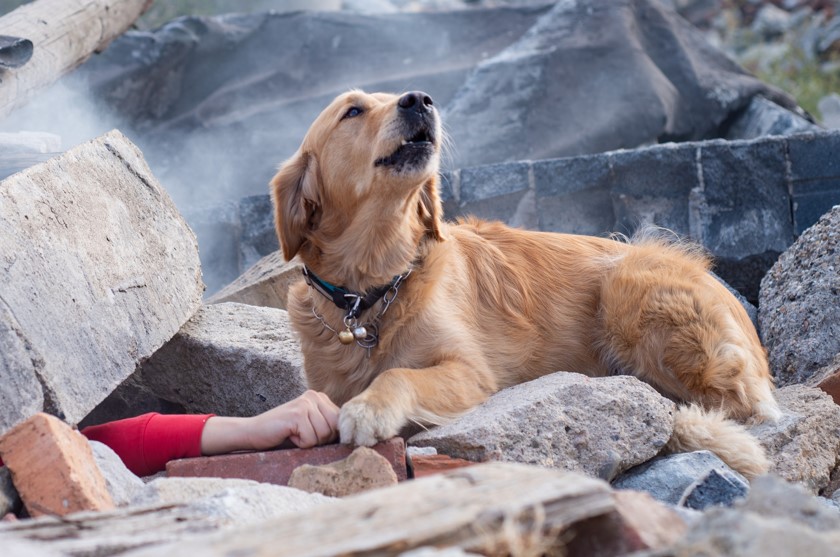
In order to refine our understanding, we questioned the definition of a search and rescue dog. Our conclusion was that a search and rescue dog is a canine that has been trained to detect human scent and indicate it to its handler with clarity, based on its keen sense of smell. To fulfill its role effectively, a search and rescue dog must be able to search intensively for extended periods during a mission. For this reason, the training must inspire a passion for searching in the dog.
Here are some of the requirements for SAR dogs:
Search and Rescue (SAR) dogs perform critical tasks in locating and communicating the location of people who are lost or trapped. The breed and size of the dog do not greatly influence its suitability for SAR work, but certain behaviors, skills, and obedience are essential for success.

The German Shorthaired Pointer is a highly versatile breed known for its intelligence, trainability, and eagerness to work. This breed has a strong desire to please and excels in tasks such as scent detection and tracking, making it an excellent choice for search and rescue operations, particularly in rubble search. Its keen sense of smell and fast, effective work style have been observed in rubble search and rescue operations. In addition to its work capabilities, the German Shorthaired Pointer is also known for its friendly and affectionate personality, making it a great companion for families. This breed's versatility, trainability, and friendly demeanor make it a top choice for both hunting and search and rescue work.
| Trait | Description |
| Breed | German Shorthaired Pointer |
| Height | Male: 23-25 inches; Female: 21-23 inches |
| Weight | Male: 55-70 pounds; Female: 45-60 pounds |
| Size | Medium to large |
| Coat | Short, thick, water-resistant, with solid liver or liver and white markings |
| Personality | Energetic, intelligent, eager to please, friendly, trainable |
| Temperament | Affectionate, loyal, playful, can be stubborn |
| Activity level | High |
| Exercise needs | At least 1-2 hours of vigorous exercise per day |
| Training needs | Requires consistent and firm training, responds well to positive reinforcement |
| Grooming needs | Minimal, occasional brushing and bathing |
| Health concerns | Hip dysplasia, eye diseases, cancer, bloat |
| Life expectancy | 10-12 years |
Successful example:
One example of a successful SAR dog of the German Shorthaired Pointer breed is K9 Nicky, who served as a search and rescue dog in the aftermath of the September 11th terrorist attacks in New York City. Nicky was able to locate survivors and provide comfort to those who were searching for loved ones. She was trained in rubble search, building search, and human remains detection, and was praised for her tireless work ethic and determination.
Another example is K9 Jäger, who was deployed to assist with disaster relief efforts in the aftermath of Hurricane Katrina in 2005. Jäger was praised for his quick and effective work style, as well as his ability to work well under challenging conditions. He was instrumental in locating survivors and helping to bring closure to families of missing persons. These examples show just how valuable and capable German Shorthaired Pointers can be as SAR dogs, and their contribution to search and rescue efforts is invaluable.

The Golden Retriever is a breed known for its friendly and obedient nature, making it a popular choice for families and SAR work. With a strong desire to please their owners and a love of play, Golden Retrievers are highly trainable and eager to learn new tasks. They have a strong sense of smell and an ability to focus on their work, making them effective in search and rescue operations. In addition to their work ethic, Golden Retrievers are known for their loving and affectionate personalities, and are often referred to as "gentle giants". With their friendly demeanor and trainability, Golden Retrievers are a popular breed for SAR work and make excellent companions for families.
| Trait | Description |
| Breed | Golden Retriever |
| Height | Male: 23-24 inches; Female: 21.5-22.5 inches |
| Weight | Male: 65-75 pounds; Female: 55-65 pounds |
| Size | Large |
| Coat | Dense, water-repellent, with golden or cream-colored fur |
| Personality | Friendly, intelligent, loyal, eager to please |
| Temperament | Patient, calm, easygoing, adaptable |
| Activity level | Moderate |
| Exercise needs | At least 1-2 hours of exercise per day |
| Training needs | Responds well to positive reinforcement, requires consistent training |
| Grooming needs | Regular brushing and occasional bathing |
| Health concerns | Hip and elbow dysplasia, eye diseases, cancer, heart disease |
| Life expectancy | 10-12 years |
Successful example:
One notable example of a successful Golden Retriever SAR dog is Ace, who was deployed in search and rescue operations in the aftermath of Hurricane Katrina in 2005. Ace, who was trained by the National Disaster Search Dog Foundation, located several survivors in the rubble and helped to provide comfort and support to those affected by the disaster.
Another successful Golden Retriever SAR dog is Hunter, who was deployed in search and rescue operations in the aftermath of the 9/11 terrorist attacks in New York City. Hunter, who was trained by the Federal Emergency Management Agency (FEMA), worked tirelessly in the rubble to locate survivors and provide comfort to those affected by the tragedy.

The Labrador Retriever is a breed renowned for its friendly, outgoing, and obedient nature. Its trainability and high intelligence make it a popular choice for families and for search and rescue work. With a strong desire to please their owners, Labrador Retrievers are eager to learn and excel in tasks such as scent detection and tracking. They have a keen sense of smell and are known for their tireless work ethic, making them effective in search and rescue operations. In addition to their work capabilities, Labrador Retrievers are known for their playful and affectionate personalities, making them excellent companions for families. Their friendly and social demeanor, combined with their trainability and intelligence, make Labrador Retrievers a top choice for search and rescue work.
| Trait | Description |
| Breed | Labrador Retriever |
| Height | Male: 22.5-24.5 inches; Female: 21.5-23.5 inches |
| Weight | Male: 65-80 pounds; Female: 55-70 pounds |
| Size | Large |
| Coat | Short, thick, water-resistant, with black, chocolate, or yellow fur |
| Personality | Friendly, outgoing, intelligent, trainable |
| Temperament | Energetic, loyal, playful, can be mischievous |
| Activity level | High |
| Exercise needs | At least 1-2 hours of exercise per day |
| Training needs | Highly trainable, responds well to positive reinforcement |
| Grooming needs | Regular brushing and occasional bathing |
| Health concerns | Hip and elbow dysplasia, eye diseases, obesity |
| Life expectancy | 10-12 years |
Successful example:
A successful Labrador Retriever SAR dog is a dog named Cheyenne, who was part of the search and rescue team that worked to find survivors after the 9/11 attacks at the World Trade Center. Cheyenne was able to locate multiple survivors and her tireless search efforts helped bring comfort and closure to the families of those who were lost. Another example is a dog named Chaser, who was a Labrador Retriever SAR dog who assisted in search and rescue missions after hurricanes and other natural disasters. She was also known for her work finding missing persons and participating in evidence searches.

Welsh Corgis are known for their intelligence, eagerness to please, and strong sense of smell, which are all key characteristics that make them well-suited for search and rescue work. Their high energy and playful nature also helps them to stay motivated during long search missions. Additionally, their small size allows them to easily access tight spaces and maneuver through difficult terrain, making them effective in locating victims in rubble or other hazardous environments.
Furthermore, Welsh Corgis have a strong drive to work and are quick learners, which enables them to be trained in various search and rescue techniques. Overall, their combination of intelligence, physical ability, and desire to work make Welsh Corgis highly capable and effective search and rescue dogs.
| Trait | Description |
| Breed | Welsh Corgi |
| Height | Male: 10-12 inches; Female: 10.5-12.5 inches |
| Weight | Male: 25-30 pounds; Female: 30-38 pounds |
| Size | Small |
| Coat | Short, thick, with various colors and markings |
| Personality | Affectionate, loyal, intelligent, playful |
| Temperament | Bold, confident, independent, can be stubborn |
| Activity level | Moderate |
| Exercise needs | At least 30-60 minutes of exercise per day |
| Training needs | Requires consistent and patient training, can be stubborn |
| Grooming needs | Regular brushing and occasional bathing |
| Health concerns | Hip dysplasia, eye diseases, back problems |
| Life expectancy | 12-14 years |
Note: Hunting dogs can be used in wilderness areas but may have difficulties and sometimes be impossible to use. On the other hand, hunting dogs can perform well on rubble. It's not important how a dog locates a victim, but it's essential to have a clear and reliable alert from the dog to the handler.
Q: What are SAR dogs?
A: SAR dogs, or search and rescue dogs, are highly trained dogs that assist in disaster response efforts. They use their incredible sense of smell to locate missing persons and bring them to safety.
Q: What should be taken into account when looking for a breeder for a new SAR dog?
A: A successful match depends on finding the right breeder for the job. Interviews should be conducted to make sure the pup is up to the standards needed for SAR work - seeking someone who specializes in working dogs as opposed to show breeds is recommended.
Q: How do we ensure retired SAR dogs stay comfortable and happy?
A: Retired SAR dogs need regular vet visits, a safe environment, nutritious meals, and activities to keep them occupied. They deserve lots of love and respect - just like they did while they were working!
Q: What is the history of search and rescue dogs?
A: The use of search and rescue dogs can be traced back to the use of Red Cross dogs during World War I. They were initially trained to bark at the location of wounded soldiers, but this method was changed to picking up a designated item. Today, search and rescue dogs have been used in various disasters around the world, such as earthquakes, and have proven to be a valuable asset in saving lives and recovering bodies.
Q: How do SAR dogs locate missing persons?
A: SAR dogs use their keen sense of smell to quickly locate missing persons. They work closely with their human handlers to search areas that would be too dangerous or time-consuming for human teams to search.
Q: What breeds are best suited for search and rescue work?
A: Many breeds can be trained for search and rescue, but some of the most commonly used breeds include German Shepherds, Labrador Retrievers, Golden Retrievers, and Belgian Malinois. The breed chosen will depend on the specific requirements of the search and rescue organization, as well as the individual dog's temperament and ability.
